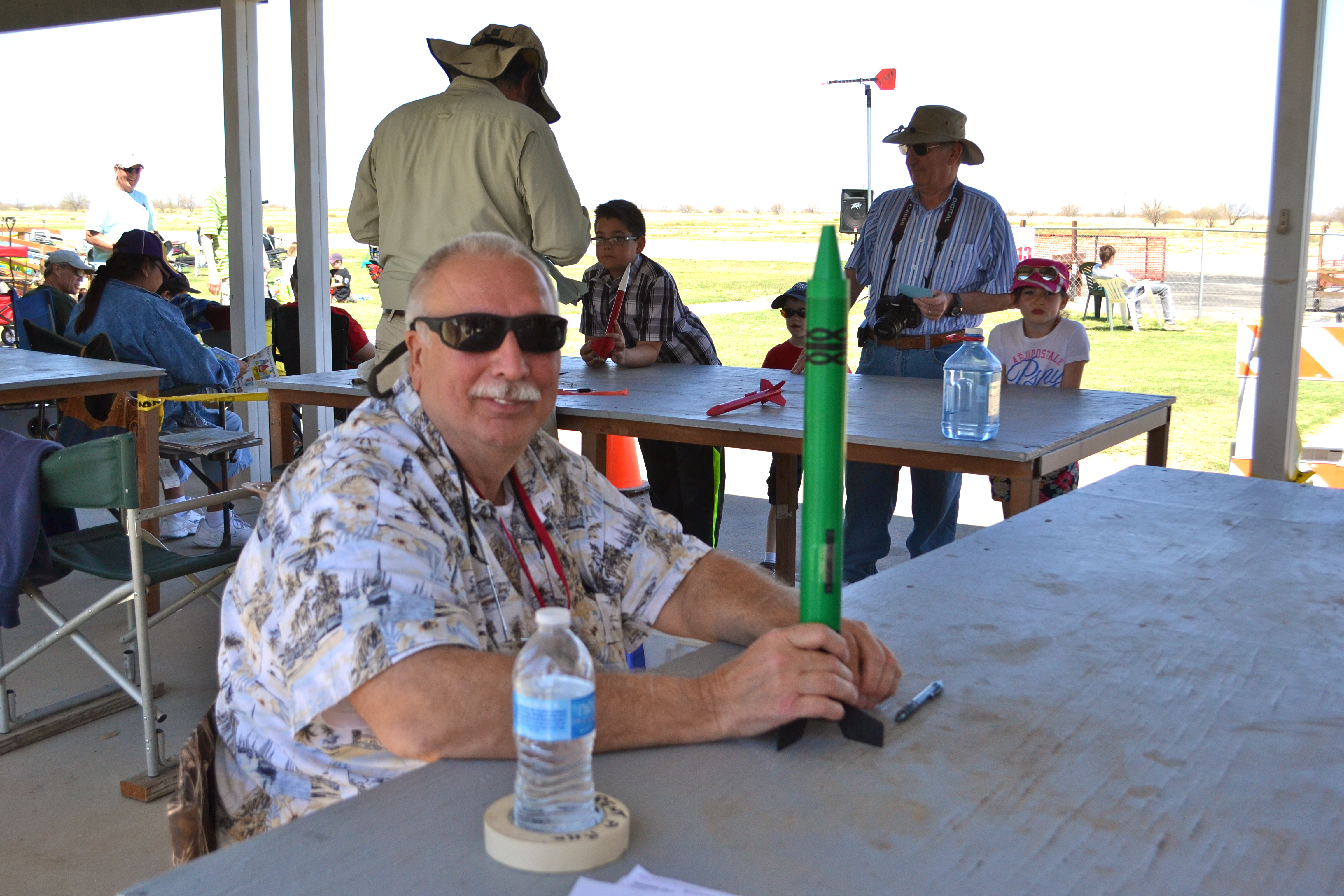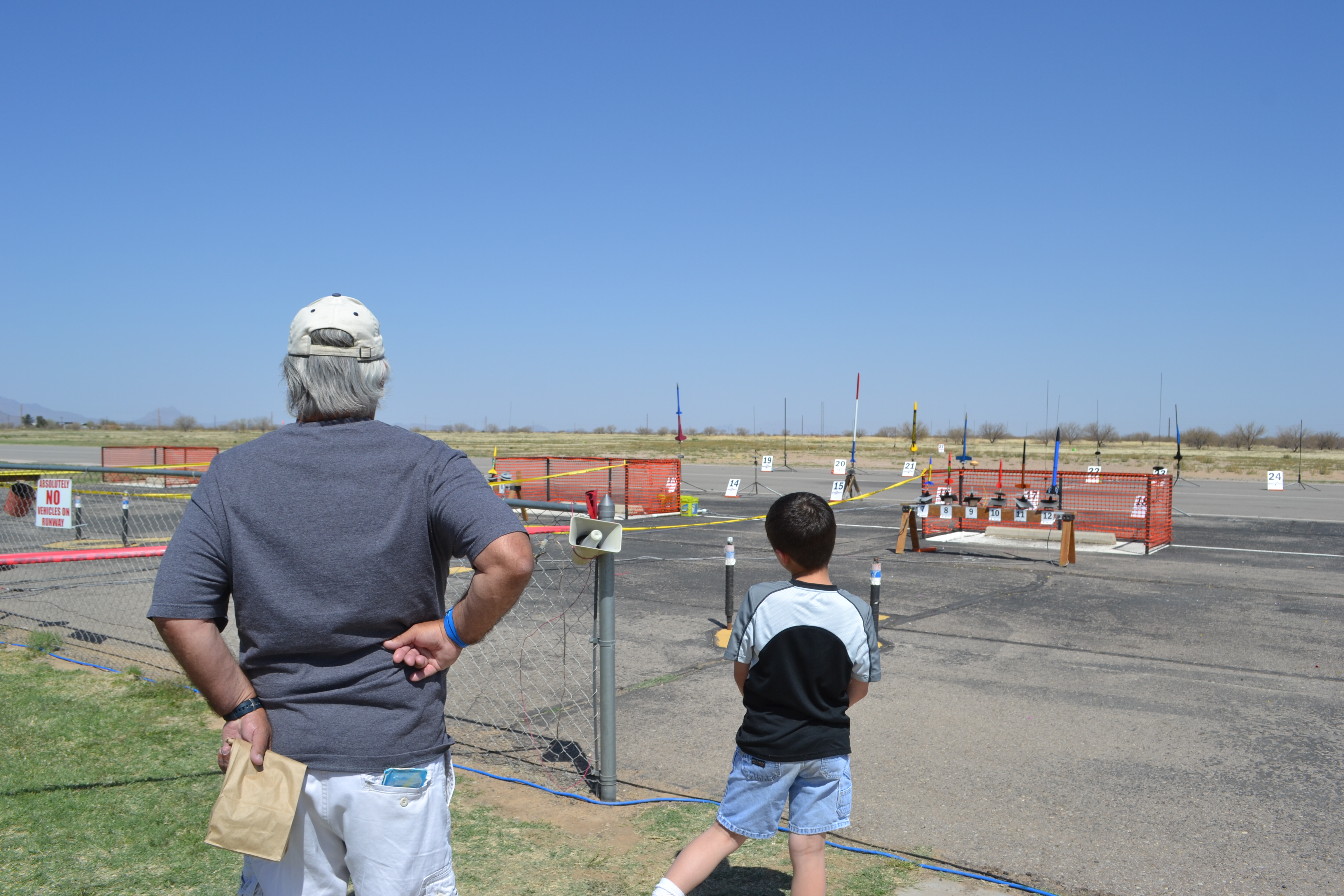
Tarantula Hawk’ blasts off
It’s the second to last weekend of March and Sean Kean is pacing back-and-forth clutching a microphone in his hand as he read’s off of a sheet of paper:
“Pad 21 now, where we have John’s ‘Tarantula Hawk’ on a I-327, expected to go to about 2,800 feet”
“That’s almost 3,000 feet” a young spectator realizes.
All spectators gaze to the sky as they watch the rocket’s ascent. Listen closely, and you can hear some of their nervous voices quietly chanting “separate, c’mon, separate”
A small explosion releases a parachute that gently glides the rocket back to meet its owner. Sighs of relief, as there is no malfunction in which the parachute can be tangled upon release, increasing the rockets velocity as it descends often dangerously and unpredictably toward spectators below.
Dogging rockets is always fun.
Rockets in the Desert

Desert Heat 2013 gathers for a group photo while holding two large rockets from The Arizona Rocketry Team launched earlier
Kean is president of the Southern Arizona Rocketry Association, primarily run by him and a small group of board members.
“Our goal is to get well known by Tucson,” said Kean who wants “people in Tucson to know that there’s a rocketry club here for small model rockets or for the bigger rockets”
At SARA’s annual two-day event, Desert Heat, nearly 100 rocketeers and enthusiasts head West to a vast, open plot of land on the outskirts of Tucson where smaller monthly launches are also hosted. Here, nearly 1,000 rockets are launched over the course of the weekend.
After Kean assures himself that a bird in the distance is in-fact a bird and not an airplane, he deems it safe to launch.
“Pad 21 launching ‘Tarantula Hawk’ in five, four, three, two, one, launch”
The black and yellow rocket might have looked like a killer bee, however it sounded more like a nuclear missile. Or the bowels of God.
Compared to the quick hiss of smaller rockets, this rocket produces a much deeper, throatier noise. It howls.
A dramatic billowing cloud of black smoke shaped like an upside-down mushroom cloud bleeds from the fiery engine exhaust and blankets the launch pad.
“Woaaahhh” say the spectators in unison as ‘Tarantula Hawk’ soars out of vision to it’s almost 3,000 foot climax. Applause roars and children immediately tug on their parents and beg to “do that”.
“Smoke and fire … that’s what this hobby’s all about,” Kean announces.
A Family Affair
Members of SARA have been launching rockets for 17 years. Many members became enamored with rocketry at a young age. Steve Lubliner, the National Association of Rocketry senior section advisor for Tucson and chairman of the Safety Committee for SARA has flown rockets for more than four decades.
“I’m very fortunate as I was able to turn a hobby into what I do for a living,” said Lubliner, an engineer at Raytheon whose father was an aeronautical engineer. Rocketry is a part of Lubliner’s lineage, who added that he flew his first rocket in 1969, the same year as the lunar landing.
Rocketry encompasses many disciplines, said Lubliner. “Rocketry is a good tool for learning about basic math and science, or even just pride in building something,” added Lubliner.
“Going forward we need to get more young people involved in those sciences,” said SARA board member Ken Weaver.
Families are admittedly one of, if not the biggest selling point of rocketry today. “In the hobby, we try to push the family aspect of it because the six, seven or 10 year-olds are the rocketeers of tomorrow,” said Lubliner.

Rocketry involves many disciplines which make it a hobby for everyone
SARA makes the effort, too. Weaver is their ember at large and is head of Community Outreach, which means he organizes outreach events at schools, groups like cub scouts and other science organizations.
“We get to explain the principles behind rocketry and sometimes help them build and fly their own rockets,” said Weaver.
Never too late

Ken Weaver at a Desert Hear 2013 check-in table
And if you think you might be past your prime to pick-up the hobby, think again.
“I always say ages two to 102”, said Weaver. “We have fliers out here who are 82 years-old, in fact one of our fliers didn’t even start the hobby until he was 78 years-old,” chuckles Weaver.
“We have a lot of ‘born-again’ rocketeers, many of whom did rocketry as kids but got out of it. So now they have kids who are interested in rocketry and got back into it,” said Lubliner.
Today rocketry is widespread, too.
“I fly all over the country, in-fact I’ve got one rocket and the goal was to fly it in all 50 states,” said Lubliner who noted that a greater availability of ‘ready to fly’ rocket kits for beginners, more powerful engines and advanced electronics including A/V and GPS add sophistication to the hobby today.

Old and young; rocketeers of all ages participated at Desert Heat 2013
Tarantula Hawk is back with it’s owner and Kean is ready to announce the next launch. Rockets of all sizes are prepped for launch and the children standing next to their parents watch in anticipation.
The launch may draw spectators of all sizes, though it is clear that these rocket enthusiasts are all children at heart.
For more information on Desert Heat and monthly launches visit the Southern Arizona Rocketry Association (SARA) at www.sararocketry.org or for general information visit the National Association of Rocketry at www.nar.org

